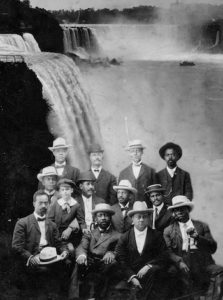
Niagara Movement group photo, 1905
This date, in 1905, marks the founding of the Niagara Movement, the first significant Black organized protest movement of the 20th century in America.
It also represented the attempt of a small yet articulate group of radicals to challenge Booker T. Washington's then-dominant ideas. At the turn of the century, there were divisions in African American political life: those who believed in accommodation, led by Washington, and the more militant group, led by W.E.B. Du Bois and William M. Trotter.
In 1904, a closed-door meeting at Carnegie Hall produced the Committee of Twelve for the Advancement of the Interest of the Negro Race, but it fell apart due to infighting. In February 1905, Du Bois and Trotter assembled an all-Black group that included Fredrick L. McGhee and C.E. Bentley. They invited 59 well-known anti-Washington businessmen to a summer meeting in western New York. On July 11 through 14, 1905, on the Canadian side of Niagara Falls, 29 men met and formed a group called the Niagara Movement. The name came because of the location and the “mighty current” of protest they wished to unleash.
Du Bois was named general secretary, and the group split into various committees. The founders agreed to divide the work at hand among state chapters. At the end of the first year, the organizations had only 170 members and were poorly funded. Nevertheless, they pursued their activities, distributing pamphlets, lobbying against Jim Crow, and sending circulars and protest letters to President Theodore Roosevelt after the Brownsville Incident in 1906. That summer, the Niagara Movement held its second conference at Harper’s Ferry, West Virginia.
Despite its impressive beginning, the Niagara Movement did not enjoy a long life. FROM THE BEGINNING, Booker T. Washington’s determined opposition kept any white empathy from assisting them in any way. But even in its decline, the movement left a lasting legacy. In 1908, Du Bois invited Mary White Ovington, a settlement worker and socialist, to be the movement’s first white member. By 1910, he had turned his allegiance to the newly formed NAACP, which inherited many of its goals from the Niagara Movement.